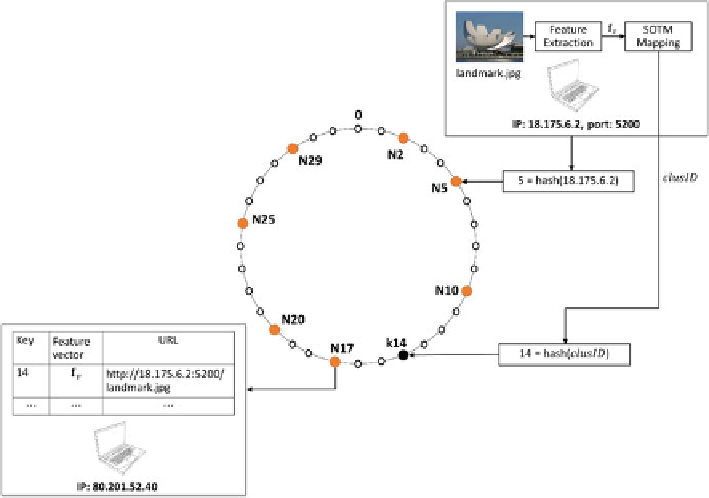Database Reference
In-Depth Information
two similar images, i.e.,
f
v
1
=
f
v
2
,Eq.(
8.3
) will quantize them into the same cluster:
Q
. They will have the same hash value.
After the key of an image is obtained, the system can construct an index entry in
the form of
(
f
v
1
)=
Q
(
f
v
2
)
, where
f
v
is the feature vector; URL is the IP address,
the port address, and the image name. The Chord network will forward this index
message to the node responsible for the key. The node will insert this index entry
into its local storage, where the indexes with the same key are gathered into the
same list to facilitate the localization of local indexes.
Figure
8.3
shows an example of indexing on a Chord ID space of size 2
5
, i.e.,
<
key
,
f
v
,
URL
>
m
5. It is assumed that seven nodes have already joined the group. The node
N5 is assigned the ID as 5
=
, and has an image file named
“Landmark” that needs to be shared with its peers. The node uses the cluster ID
of the image and makes a hash of the cluster ID, to get the key
=
hash
(
18
.
175
.
6
.
2
)
=
14. Since the
closest node to key 14 is node N17, N5 creates an index message
<
hash(
clusID
),
f
v
,
http://18.175.6.2:5200/Landmark.jpg
and sends this message to be stored in node
N17. In other words, the image file is stored in N5, and the key of the file is k14 (a
point in the DHT ring), but the reference to file is stored in node N17. In the query
processing state, other nodes can first find N17, extract the references, and then use
the references to access the image file.
>
Indexing of nodes and data items on a Chord ID space of size 2
5
Fig. 8.3

Search WWH ::

Custom Search